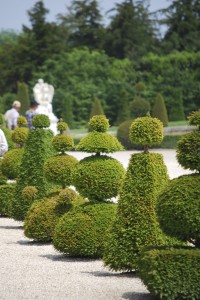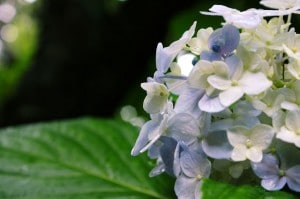
Looks great at Versailles, but how would this look go over in New York and Connecticut gardens?
What do you think of when you hear the word “pruning”? Is it dried plums? Your fingers and toes after a long soak in the tub? The wildly whimsical, swirling topiaries of ornate palaces like Versailles? (Would that whimsy go over well in New York or Connecticut landscapes?)
Well, pruning — and the more practical-sounding tree trimming — is actually a very important part of keeping any landscape looking its best — even if none of your shrubs are cut into the shape of giraffes or dancing bears. Pruning and trimming will help your shrubs and trees grow into their fullest, healthiest forms.
Here are some of the facts you should know before tackling or, better yet, hiring someone to tackle this crucial landscape task.
Tools of the trade
First, there’s a big difference between tree trimming and shrub pruning (though both require considerable skill). Anything 15 feet tall or less is considered a shrub; anything taller is a tree.
Common tree trimming tools include chain saws, pole saws and pole pruners, as well as multiple extenders for especially tall trees — items most businesses wouldn’t find lying around the garage and generally don’t have much use for.
For shrub pruning, you’ll need tools like hand pruners, a hand saw and good shears.
Tree trimming
For large trees like maple trees, oak trees or ash trees, you should perform maintenance tree trimming at least every other year. (That means eliminating dead wood, branches that are crossed or rubbing together, and broken limbs.) When you do perform this tree trimming, you’ll need to bring in an arborist and tree crew.
And if you’re removing a major tree from your landscape, be sure to choose a local New York or Connecticut tree trimming company that’s fully insured and established (hint: Neave Group Landscape Management is one of them). It’s a big job with many considerations — not the task to be looking for the best bargain out there.
Spring shrub pruning
 Shrub pruning is better suited to shrubs around your yard, as well as small trees like dogwoods and Japanese maples.
Shrub pruning is better suited to shrubs around your yard, as well as small trees like dogwoods and Japanese maples.
Reduce the size of your small trees by trimming back the outer branches 25 to 30 percent. You can also clean out your tree’s interior by using hand pruners to get rid of branches that aren’t producing.
It’s especially important to know the plant material at hand! Certain plant types can’t recover as quickly or completely as others if pruned incorrectly. Some plants, like boxwood, can be shaped with hand shears or pruned with hand pruners for form. Other shrubs, like hydrangeas, must be pruned in the proper season (if you prune at the wrong time, you risk snipping flower-bearing branches for the coming season).
That’s just one of many reasons to bring in the professionals. Neave Group’s Landscape Management professionals have the horticultural experience and all the necessary tools to get the job done right the first time.
Shrub pruning for every season
Spring in New York and Connecticut is the time for a good prune on all your outdoor plant life. Neave Group Landscape Management will remove any spent plants and reshape your existing flower beds for the best seasonal performance.
In the summer, we’ll ensure your plant life is living up to its potential and all your beds are flourishing the way you want them to.
And in the fall, as your landscape’s high season comes to an end, we’ll prepare it for winter by cleaning and clearing out spent flower beds, and adding fall annuals to keep things colorful as long as possible.
Give us a call to discuss your tree trimming and shrub pruning needs this season. We maintain commercial properties throughout New York, New Jersey and Connecticut. Our team welcomes your call at (845) 463-0592. Or, simply fill out our handy web form to the right and we’ll get in touch with you as soon as possible.
images credits: Paige Worthy (Versailles), titanium22